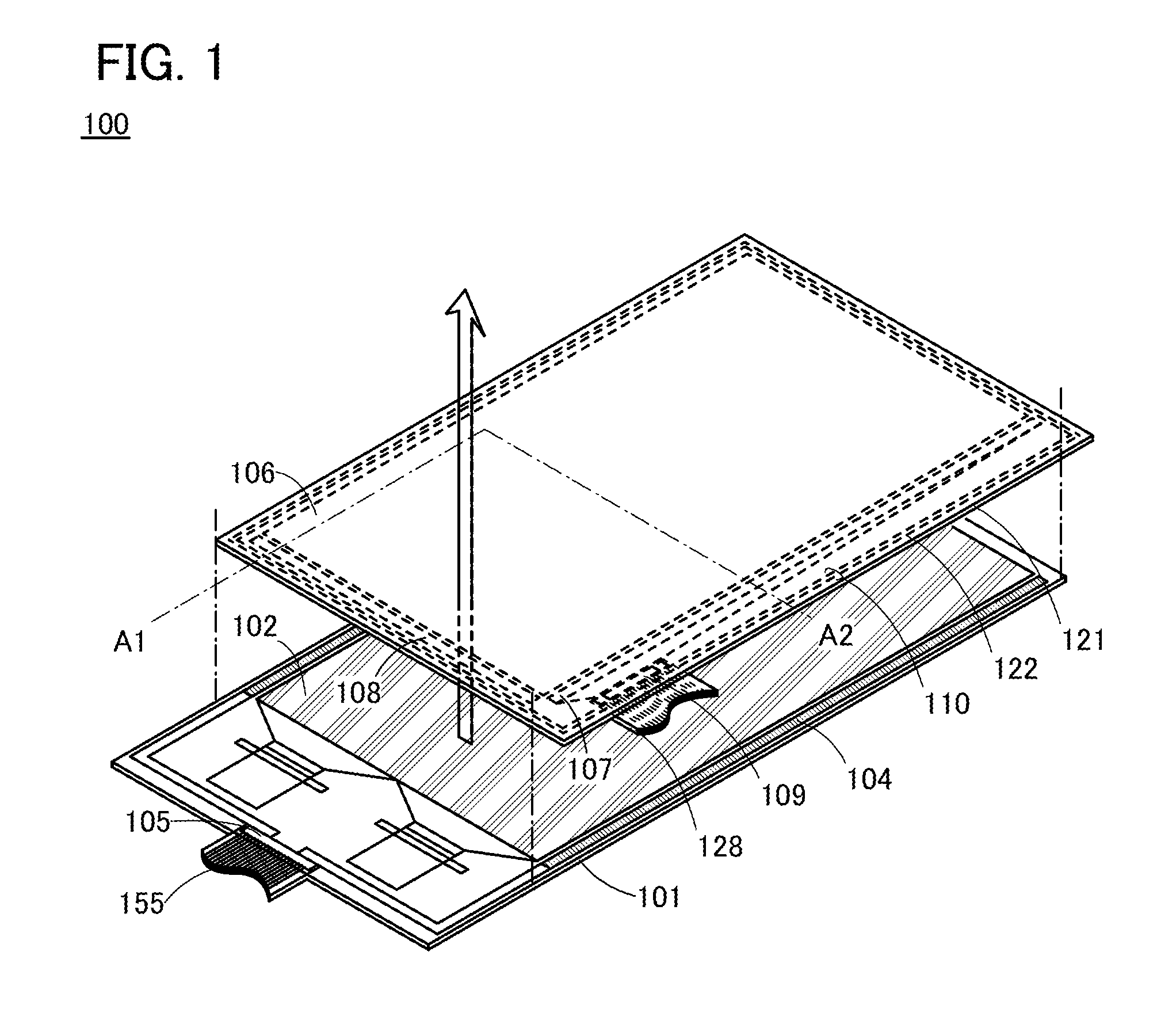Input and output device
a display device and input and output technology, applied in thermoelectric devices, solid-state devices, instruments, etc., can solve the problems of cracking, cracking, and a thin film in the end portion of the substrate that is difficult to separate and divide, and achieves high bending stress
- Summary
- Abstract
- Description
- Claims
- Application Information
AI Technical Summary
Benefits of technology
Problems solved by technology
Method used
Image
Examples
embodiment 1
[0048]In Embodiment 1, an example of an input and output device (also referred to as input / output device) of one embodiment of the present invention is described. A structure and a manufacturing method of a touch panel in which an image display device is incorporated with an input device will be described with reference to drawings.
[0049]An example of the image display device in Embodiment 1 is a touch panel including an organic electroluminescence (EL) element.
[Structure Example of Touch Panel]
[0050]FIG. 1 is a projection view illustrating a structure of a touch panel 100 which is one embodiment of the present invention. FIG. 2 is a cross-sectional view of the touch panel 100 taken along dashed-dotted line A1-A2 in FIG. 1. Note that some components are not illustrated in FIG. 1 and FIG. 2 for clarity.
[0051]The touch panel 100 includes an image display device 180 and an input device 190 (see FIG. 2).
[0052]The touch panel 100 includes, on a surface of a first substrate 121 opposite t...
modification example 1
[Modification Example 1]
[0242]FIG. 9 is a cross-sectional schematic view of the touch panel 100 of one embodiment of the present invention in which one electrode of the sensor element 118 is formed in the same process as a semiconductor layer. The main differences of FIG. 9 from FIG. 2 are that two layers, an oxide semiconductor layer 173a and an oxide conductor layer 173b, are formed using an oxide semiconductor and that an insulating layer 175a is formed. The oxide semiconductor layer 173a includes a region functioning as a channel in the transistor in the input device 190. The oxide conductor layer 173b functions as one electrode of the sensor element 118. The differences from FIG. 2 will be described.
[0243]Note that in this specification and the like, the oxide conductor layer can also be referred to as an oxide semiconductor layer having a high carrier density and a low resistance, an oxide semiconductor layer having conductivity, an oxide semiconductor layer having high conduc...
modification example 2
[0262]FIG. 10 is a cross-sectional schematic view of the touch panel 100 of one embodiment of the present invention in which one electrode of the sensor element 118 is formed in the same process as a semiconductor layer. The main difference of FIG. 10 from FIG. 9 is that the conductive layer 178, which is the other electrode of a sensor element, is formed closer to the light-emitting element 114 than the color filer 127. The differences from FIG. 9 will be described.
[0263]The black matrix 126 and the color filter 127 are provided over the insulating layer 177. The conductive layer 178 is provided over the color filter 127 and the black matrix 126 with the insulating layer 179 therebetween. Note that the conductive layer 178 may be provided directly on the color filter 127 and the black matrix 126 without the insulating layer 179. An insulating layer may be provided over the conductive layer 178.
[0264]The conductive layer 178 is provided far from the oxide conductor layer 173b, which...
PUM
 Login to View More
Login to View More Abstract
Description
Claims
Application Information
 Login to View More
Login to View More - R&D
- Intellectual Property
- Life Sciences
- Materials
- Tech Scout
- Unparalleled Data Quality
- Higher Quality Content
- 60% Fewer Hallucinations
Browse by: Latest US Patents, China's latest patents, Technical Efficacy Thesaurus, Application Domain, Technology Topic, Popular Technical Reports.
© 2025 PatSnap. All rights reserved.Legal|Privacy policy|Modern Slavery Act Transparency Statement|Sitemap|About US| Contact US: help@patsnap.com



